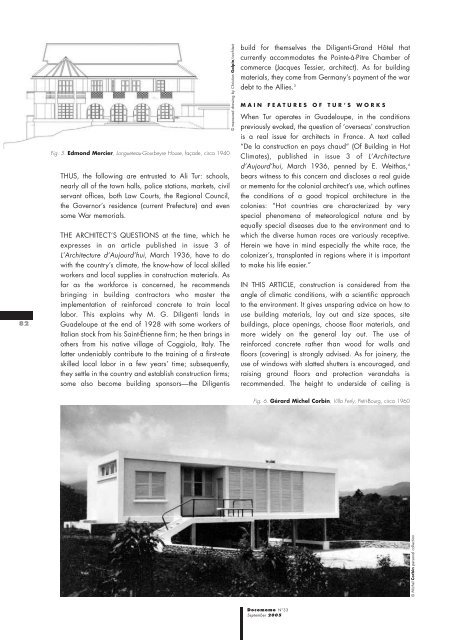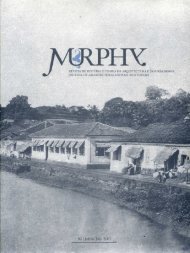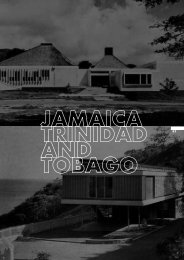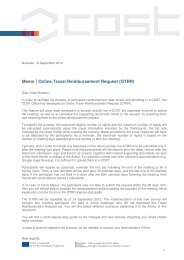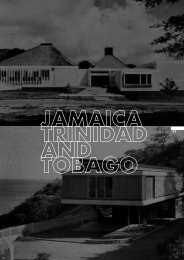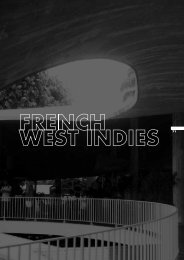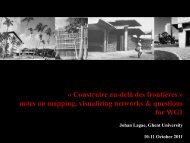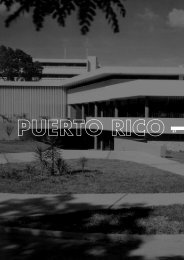Guadeloupe : The Modern Transition
Guadeloupe : The Modern Transition
Guadeloupe : The Modern Transition
Create successful ePaper yourself
Turn your PDF publications into a flip-book with our unique Google optimized e-Paper software.
82<br />
Fig. 5. Edmond Mercier, Longueteau-Gourbeyre House, façade, circa 1940<br />
THUS, the following are entrusted to Ali Tur: schools,<br />
nearly all of the town halls, police stations, markets, civil<br />
servant offices, both Law Courts, the Regional Council,<br />
the Governor’s residence (current Prefecture) and even<br />
some War memorials.<br />
THE ARCHITECT’S QUESTIONS at the time, which he<br />
expresses in an article published in issue 3 of<br />
L’Architecture d’Aujourd’hui, March 1936, have to do<br />
with the country’s climate, the know-how of local skilled<br />
workers and local supplies in construction materials. As<br />
far as the workforce is concerned, he recommends<br />
bringing in building contractors who master the<br />
implementation of reinforced concrete to train local<br />
labor. This explains why M. G. Diligenti lands in<br />
<strong>Guadeloupe</strong> at the end of 1928 with some workers of<br />
Italian stock from his Saint-Étienne firm; he then brings in<br />
others from his native village of Coggiola, Italy. <strong>The</strong><br />
latter undeniably contribute to the training of a first-rate<br />
skilled local labor in a few years’ time; subsequently,<br />
they settle in the country and establish construction firms;<br />
some also become building sponsors––the Diligentis<br />
© measured drawing by Christian Galpin/architect<br />
build for themselves the Diligenti-Grand Hôtel that<br />
currently accommodates the Pointe-à-Pitre Chamber of<br />
commerce (Jacques Tessier, architect). As for building<br />
materials, they come from Germany’s payment of the war<br />
debt to the Allies. 3<br />
MAIN FEATURES OF TUR’S WORKS<br />
When Tur operates in <strong>Guadeloupe</strong>, in the conditions<br />
previously evoked, the question of ‘overseas’ construction<br />
is a real issue for architects in France. A text called<br />
“De la construction en pays chaud” (Of Building in Hot<br />
Climates), published in issue 3 of L’Architecture<br />
d’Aujourd’hui, March 1936, penned by E. Weithas, 4<br />
bears witness to this concern and discloses a real guide<br />
or memento for the colonial architect’s use, which outlines<br />
the conditions of a good tropical architecture in the<br />
colonies: “Hot countries are characterized by very<br />
special phenomena of meteorological nature and by<br />
equally special diseases due to the environment and to<br />
which the diverse human races are variously receptive.<br />
Herein we have in mind especially the white race, the<br />
colonizer’s, transplanted in regions where it is important<br />
to make his life easier.”<br />
IN THIS ARTICLE, construction is considered from the<br />
angle of climatic conditions, with a scientific approach<br />
to the environment. It gives unsparing advice on how to<br />
use building materials, lay out and size spaces, site<br />
buildings, place openings, choose floor materials, and<br />
more widely on the general lay out. <strong>The</strong> use of<br />
reinforced concrete rather than wood for walls and<br />
floors (covering) is strongly advised. As for joinery, the<br />
use of windows with slatted shutters is encouraged, and<br />
raising ground floors and protection verandahs is<br />
recommended. <strong>The</strong> height to underside of ceiling is<br />
Fig. 6. Gérard Michel Corbin, Villa Ferly, Petit-Bourg, circa 1960<br />
© Michel Corbin personal collection<br />
Docomomo N°33<br />
September 2005


